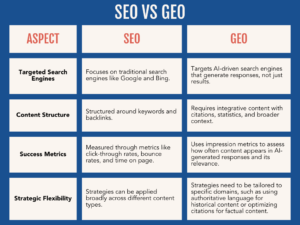The digital landscape has undergone a seismic shift with the rise of artificial intelligence (AI) and machine learning (ML). These advancements have permeated various industries, influencing everything from healthcare to finance, and now they’re making a big splash in the realm of digital marketing and search engine optimization (SEO). One of the most innovative applications of AI in this field is Generative Engine Optimization (GEO). But what exactly is GEO, and how does it differ from traditional SEO practices? This comprehensive guide aims to answer these questions, exploring the origins, benefits, and potential challenges of GEO.
The Evolution of SEO

Before diving into GEO, it’s crucial to understand the context in which it exists—Search Engine Optimization (SEO). SEO, the practice of optimizing a website to rank higher in search engine results pages (SERPs), has been the cornerstone of digital marketing for over two decades. The goal is to make content more discoverable by users through search engines like Google, Bing, and Yahoo. Traditional SEO involves strategies such as keyword research, on-page optimization, backlink building, and more recently, optimizing for voice search and mobile devices.
As search engines became more sophisticated, SEO evolved. Initially, keyword stuffing and low-quality backlinks might have worked, but search algorithms have become better at understanding user intent, content relevance, and site quality. Today, ranking well in SERPs requires a multi-faceted approach that includes technical SEO, content quality, user experience, and mobile optimization.
However, as with any technology-driven industry, change is inevitable. Enter Generative Engine Optimization (GEO), a new frontier that promises to revolutionize how we approach SEO through the power of AI and machine learning.
What is Generative Engine Optimization (GEO)?
At its core, Generative Engine Optimization (GEO) leverages AI to optimize content creation, search ranking, and digital marketing strategies. The “generative” aspect refers to the AI’s ability to generate content, keywords, metadata, and even entire marketing strategies based on data-driven insights.
Where traditional SEO focuses on manual adjustments—like updating meta descriptions, conducting keyword research, and building backlinks—GEO automates much of this process. By using AI models, like GPT (Generative Pretrained Transformer) and other machine learning algorithms, GEO systems can create highly optimized content, predict trends, and make real-time adjustments based on user behavior and search engine algorithm changes.
The potential benefits are vast: faster content generation, more accurate keyword targeting, and the ability to adapt quickly to changes in search engine algorithms. But with these benefits come new challenges and questions, such as ethical considerations, reliance on AI, and how to maintain a human touch in content.
How GEO Differs from Traditional SEO

1. Content Generation
One of the most significant differences between GEO and traditional SEO lies in content generation. Traditional SEO involves human writers crafting articles, blogs, and web pages optimized for search engines. Keyword research is conducted manually or with the help of tools like Ahrefs, SEMrush, or Google Keyword Planner, but ultimately, it’s a human who creates the content.
With GEO, AI-driven models take the lead. These models are capable of generating content based on a specific set of parameters, such as target keywords, user intent, and even tone. The content can be tailored in real-time to match search trends or user behavior, offering dynamic, data-backed content strategies.
For example, if an e-commerce website needs a product description optimized for SEO, GEO tools can analyze the top-ranking pages in that category and generate content that is more likely to perform well in search results. This removes much of the guesswork involved in traditional SEO.
2. Automation and Scalability
Traditional SEO involves a labor-intensive process that requires continuous monitoring and updating. SEO specialists must keep up with algorithm changes, track keyword performance, and adjust their strategies accordingly. While various tools help automate some of these tasks, a significant amount of manual work is still required.
GEO takes automation to the next level by using AI to not only monitor performance but also to make adjustments in real-time. For instance, if a blog post starts to underperform, the AI can automatically tweak the keywords, update the content, or adjust the internal linking structure to improve rankings. This level of automation allows for much greater scalability, enabling businesses to optimize large volumes of content without the need for an equally large SEO team.
3. Predictive Analytics
One of the most powerful features of GEO is its predictive capabilities. Traditional SEO relies heavily on historical data to make decisions—past keyword performance, backlinks, and site traffic. While effective, this approach is reactive rather than proactive.
GEO, on the other hand, uses AI models to predict future trends, allowing marketers to get ahead of the curve. By analyzing data such as social media trends, competitor strategies, and user behavior, GEO tools can forecast what keywords or topics will likely be important in the future. This allows businesses to create content that is optimized for not only current search trends but also future ones, giving them a competitive edge.
The Key Components of GEO
1. AI-Powered Content Generation
AI models like GPT-4 are capable of generating human-like text based on a set of input data. In the context of GEO, this means that AI can produce blog posts, articles, product descriptions, and even social media posts that are optimized for search engines. These models can be trained to generate content that aligns with your brand voice, meets SEO criteria, and appeals to your target audience.
2. Real-Time Algorithm Adjustments
Search engines frequently update their algorithms to deliver better user experiences. GEO systems can adapt to these changes in real time. Rather than waiting for a dip in traffic to indicate that something is wrong, GEO tools can automatically detect shifts in the search engine landscape and make necessary adjustments—such as tweaking keywords, meta descriptions, or even page layouts.
3. Enhanced Keyword Research
Keyword research has always been a critical part of SEO, but it’s also one of the most time-consuming. GEO can automate this process by analyzing massive amounts of search data and identifying the best keywords for your content. Moreover, GEO can optimize for long-tail keywords, voice search queries, and even local SEO, ensuring that your content is not only optimized for search engines but also aligned with how users are actually searching.
4. Personalized User Experience
GEO doesn’t just optimize for search engines; it also optimizes for the user. By analyzing user behavior—such as time spent on a page, click-through rates, and bounce rates—GEO tools can tailor content to meet user needs better. This could involve personalizing content recommendations, adjusting page layouts for better engagement, or even dynamically changing content based on user preferences.
The Benefits of GEO
1. Faster Content Creation
One of the most significant advantages of GEO is speed. With AI handling much of the content creation, businesses can produce a higher volume of content in a shorter period. This is particularly beneficial for industries like e-commerce, where large catalogs of products require individual descriptions and blog posts.
2. Cost-Effective SEO
Traditional SEO often requires a team of specialists to manage various aspects of the process, from keyword research to backlink building. GEO reduces the need for a large team by automating many of these tasks. While there is an initial investment in the technology, the long-term savings can be substantial.
3. Adaptability
Search engine algorithms are constantly evolving, and keeping up with these changes is one of the biggest challenges for traditional SEO. GEO systems are designed to adapt to these changes in real time, ensuring that your content remains optimized even as search engines evolve.
The Challenges of GEO
1. Ethical Considerations
As with any AI-driven technology, there are ethical questions surrounding GEO. One concern is the potential for AI to generate low-quality or misleading content. While GEO tools can create optimized content quickly, it’s essential to ensure that this content is accurate, valuable, and aligned with ethical guidelines.
2. Over-Reliance on AI
Another challenge is the risk of over-relying on AI for SEO. While GEO offers many benefits, it’s crucial to remember that AI is not perfect. Human oversight is still necessary to ensure that the content aligns with brand values, is free from errors, and provides real value to users.
3. Loss of the Human Touch
One of the concerns with GEO is that it may lead to content that lacks a “human touch.” While AI can generate grammatically correct and SEO-optimized text, it may struggle to capture the nuances of human emotion and creativity. Striking a balance between AI-driven optimization and human creativity will be key to making the most of GEO.
Conclusion
Generative Engine Optimization (GEO) is poised to transform the way businesses approach SEO. By leveraging AI and machine learning, GEO offers faster content generation, real-time adaptability, and predictive analytics that can give businesses a competitive edge in the digital landscape. However, it’s not without its challenges, including ethical considerations and the need for human oversight.















Leave a Reply